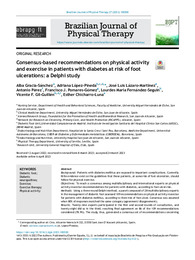Please use this identifier to cite or link to this item:
https://hdl.handle.net/11000/35004Full metadata record
| DC Field | Value | Language |
|---|---|---|
| dc.contributor.author | Gracia Sánchez, Alba | - |
| dc.contributor.author | Lopez-Pineda, Adriana | - |
| dc.contributor.author | Chicharro Luna, Esther | - |
| dc.contributor.author | LAZARO MARTINEZ, JOSE LUIS | - |
| dc.contributor.author | Pérez, Antonio | - |
| dc.contributor.author | Pomares Gómez, Francisco José | - |
| dc.contributor.author | Fernández-Seguín, Lourdes M | - |
| dc.contributor.author | Gil-Guillén, Vicente F. | - |
| dc.contributor.other | Departamentos de la UMH::Ciencias del Comportamiento y salud | es_ES |
| dc.date.accessioned | 2025-01-20T09:34:51Z | - |
| dc.date.available | 2025-01-20T09:34:51Z | - |
| dc.date.created | 2023 | - |
| dc.identifier.citation | Brazilian Journal of Physical Therapy | es_ES |
| dc.identifier.issn | 1809-9246 | - |
| dc.identifier.issn | 1413-3555 | - |
| dc.identifier.uri | https://hdl.handle.net/11000/35004 | - |
| dc.description.abstract | Background Patients with diabetes mellitus are exposed to important complications. Currently little evidence exist on the guidelines that these patients, at some risk of foot ulceration, should follow for physical exercise. Objectives To reach a consensus among multidisciplinary and international experts on physical activity/exercise recommendations for patients with diabetes, according to foot ulcer risk. Methods Using a three-round Delphi method, a panel composed of 28 multidisciplinary experts in the management of diabetic foot assessed 109 recommendations on physical activity/exercise for patients with diabetes mellitus, according to their risk of foot ulcer. Consensus was assumed when 80% of responses matched the same category (agreement/disagreement). Results Twenty-nine experts participated in the first and second rounds of consultation, and twenty-eight did so in the third, reaching final agreement on 86 of the 109 recommendations considered (78.9%). The study, thus, generated a consensus set of recommendations concerning different aspects of diabetic footcare before, during, and after exercise (e.g. when to examine the foot, how to assess it, what type of sock and insole to use, what types of exercise to perform, and when it is advisable to return to activity after an ulceration). Conclusion This Delphi study generated recommendations based on the consensus of international experts on physical activity and exercise by patient with diabetes at risk of ulceration. Recommendations considered the state of the foot and the patient's history and status before physical activity and included information on intensity, duration, frequency, and progressions of physical activity/exercise, and the use of custom-made plantar orthoses, shoe prescription, and the convenience of returning to physical activity after an ulceration. | es_ES |
| dc.format | application/pdf | es_ES |
| dc.format.extent | 16 | es_ES |
| dc.language.iso | eng | es_ES |
| dc.publisher | Elsevier | es_ES |
| dc.relation.ispartofseries | 27 | es_ES |
| dc.relation.ispartofseries | 2 | es_ES |
| dc.rights | info:eu-repo/semantics/openAccess | es_ES |
| dc.rights | Attribution-NonCommercial-NoDerivatives 4.0 Internacional | * |
| dc.rights.uri | http://creativecommons.org/licenses/by-nc-nd/4.0/ | * |
| dc.subject | Diabetic foot | es_ES |
| dc.subject | Diabetic neuropathies | es_ES |
| dc.subject | Exercise | es_ES |
| dc.subject | Exercise therapy | es_ES |
| dc.subject | Physical activity | es_ES |
| dc.subject.other | CDU::6 - Ciencias aplicadas::61 - Medicina | es_ES |
| dc.title | Consensus-based recommendations on physical activity and exercise in patients with diabetes at risk of foot ulcerations: a Delphi study | es_ES |
| dc.type | info:eu-repo/semantics/article | es_ES |
| dc.relation.publisherversion | https://doi.org/10.1016/j.bjpt.2023.100500 | es_ES |

View/Open:
Consensus-based recommendations on physical activity and exercise in patients with diabetes at risk of foot ulcerations a Delphi study.pdf
397,79 kB
Adobe PDF
Share:
.png)
